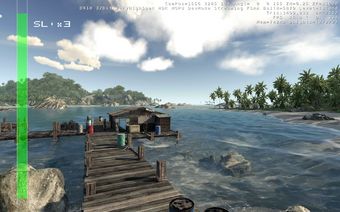NVIDIA 3-Way SLI Performance Preview
Crysis Performance

At the time of NVIDIA's 3-Way SLI launch, we were unable to bring you Crysis benchmark numbers that we felt comfortable with. This was partly an NVIDIA driver issue and also because we were waiting on a patch from Crytek that would allow for more efficient SLI scaling overall. With the release of the Cyrsis 1.1 patch, we now have a stable, scalable platform with which to test on. And as you'll see in the benchmark numbers ahead, Crysis is still an extremely taxing game.
|
 Crysis |
If you're at all into enthusiast computing, the highly anticipated single player demo of the new FPS smash-hit Crysis, should require no introduction. Crytek's game engine visuals are easily the most impressive real-time 3D renderings we've seen on a computer screen to date. The engine employs some of the latest techniques in 3D rendering like Parallax Occlusion Mapping, Subsurface Scattering, Motion Blur and Depth-of-Field effects, as well as some of the most impressive use of Shader technology we've seen yet. In short, for those of you that want to skip the technical jib-jab, Crysis is HOT. We ran the full version of the game with all of the game's visual options set to 'High' to put a significant load on the graphics cards being tested. Then we also tested at "Very High" settings to see if 3-Way SLI could handle the load. |
We have to be honest with you all. The above screen shot was taken for affect more than anything else. Regardless of what you may have envisioned, even three GeForce 8800 Ultra cards in 3-Way SLI mode, are no match for Crysis at a 1680X1050 widescreen resolution with very high image quality settings and 8X AA. Those of you who thought GPUs were no longer the bottle neck for ever increasing realism, might want to rethink things a bit. This is a pretty picture but at 16 FPS, it's a slide show in the game. That said, there are only subtle differences in image quality at "High" and "Very High" quality settings in the game's menu, but the upside performance gains can be significant as you'll see next. At very high image quality settings in the game, even at 1680X1050 with 2X AA, a single GeForce 8800 Ultra won't offer the memory bandwidth and GPU throughput required to run Crysis smoothly. However, drop in another card for SLI and things become significantly more responsive. At high quality settings and 1920X1200 resolution, the GeForce 8800 Ultra SLI setup is about 50% faster than a single card. Three GeForce 8800 Ultras in 3-Way SLI on the other hand, offer a 33% increase in performance over a pair of cards in SLI mode and a 98% performance gain over a single card. This is the type of scaling we expected to see in general from the 3-Way test machine and more in line with what NVIDIA projected for us prior to the game patch release. In this test we wanted to highlight GPU scaling efficiency even more, so we turned Crysis image quality settings back up to very high, but turned down AA just a notch to 4X. This proved to be the best case scenario in Crysis for the 3-way SLI test setup, where it outpaced a pair of cards in standard SLI by about 36% and a single card by 130%. In addition, the 3-Way setup was able to maintain overall playability in the game, at 35+ FPS, which is about as low as you'd want to limbo in a first person shooter title like this. With these numbers in mind, what's the moral of our story here? Do you actually need a 3-Way SLI setup to play Crysis at its most impressive image quality settings? Absolutely not. But if you've got the disposable income and the power budget to boot, it certainly will improve your game play. Thanks to NVIDIA's continuous improvement efforts at the driver level and the collective efforts of the company along with game developers like Crytek, mutli-GPU scaling continues to offer respectable and appreciable gains in performance.
Crysis - 1680x1050, 8X AA, Very High Quality Settings







